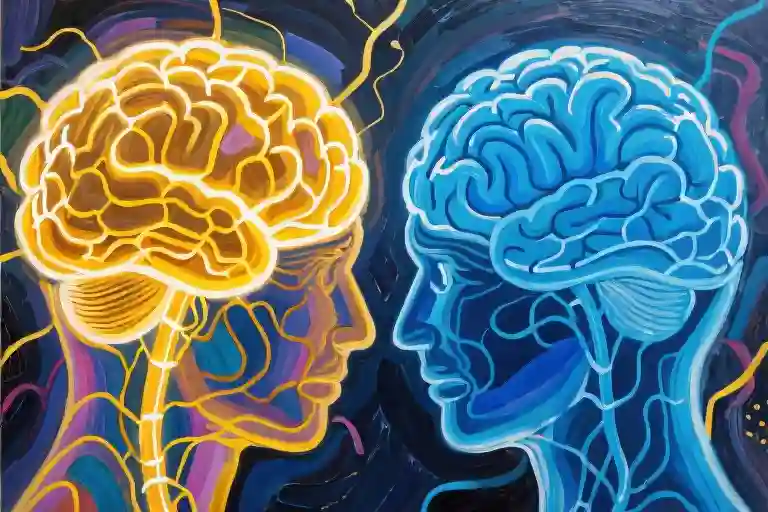The phone screen lights up the dark room for the twelfth time tonight. You know you shouldn’t check again – the read receipt from your last message still shows ‘delivered’, not ‘read’. Yet your fingers move automatically, refreshing the chat window like a gambler pulling the slot machine lever just one more time. That gnawing ache in your chest tightens as you stare at the unchanged status. Why does the silence hurt so much? And why can’t you stop reaching for what clearly isn’t reaching back?
This isn’t just about relationships. That same restless energy drives the entrepreneur checking metrics at 3AM, the shopper filling virtual carts they’ll never checkout, the gamer chasing ‘just one more level’. We’ve all felt that magnetic pull toward something just beyond our grasp – what neuroscientists call the ‘dopamine trap’. Your brain isn’t betraying you; it’s following an ancient survival mechanism gone haywire in modern contexts.
Dopamine doesn’t respond to what we have – it thrives on anticipation. Studies using brain scans show neural activity spikes 50% higher when anticipating rewards versus actually receiving them. This explains why gamblers remember near-wins more vividly than actual payouts, and why intermittent affection from an unavailable partner becomes dangerously addictive. The chemical doesn’t distinguish between healthy pursuits and destructive patterns – it simply reinforces whatever behavior preceded that delicious ‘maybe’.
Clinical observations reveal striking parallels across different chasing behaviors. My patients describe identical physical sensations whether discussing gambling losses or unrequited love: racing heartbeat when seeing their bookmaker’s notification, that same flutter when their crush’s name appears onscreen. The obsessive rumination (‘If I just text once more…’), the justification (‘This time will be different’), even the shame cycles are interchangeable. At its core, all chasing stems from the same neural wiring mistaking pursuit for survival.
But here’s what your brain won’t tell you: Chasing never satiates. Like drinking saltwater, each attempt to quench the craving only intensifies it. The temporary relief when they finally reply? That’s not fulfillment – it’s just the reset before the next craving cycle begins. Real nourishment comes from connections where your presence is celebrated, not your persistence tested. Where energy flows both ways without requiring Olympic-level effort to sustain basic attention.
The first step out of this maze isn’t willpower – it’s awareness. Notice when your body tenses scanning for notifications. Recognize that hollow excitement when crafting ‘perfect’ messages designed to elicit responses. These are neurological breadcrumbs leading you back to the real issue: You’re worthy of relationships that meet you halfway, not emotional slot machines paying out in crumbs.
Dopamine: The Invisible Director of Chasing Behavior
We’ve all experienced that relentless urge to check our phones for a text, refresh a dating app for new matches, or place ‘just one more bet’ after a loss. This insatiable chasing isn’t accidental—it’s neurochemistry in action. At the heart of these compulsive behaviors lies dopamine, our brain’s powerful motivation molecule that creates addictive feedback loops more potent than we realize.
The Neuroscience of Anticipation
Dopamine doesn’t actually reward us with pleasure—it rewards us with craving. Research shows our brains release 50% more dopamine when anticipating a reward than when actually receiving it. This explains why:
- Gamblers feel most excited before the dice roll
- Dating app users obsess over potential matches rather than actual dates
- People in imbalanced relationships fixate on sporadic affection
Like a slot machine programmed for ‘near misses,’ our brains become wired to value the chase itself. The unpredictability—whether in gambling, shopping, or relationships—creates a biological addiction far stronger than consistent rewards.
Case Study: The Gambler’s Fallacy in Love
In treating gambling addiction, I observe identical neural patterns in emotional chasing. Patients describe:
- The ‘Almost Won’ Fantasy:
“If I just text one more time…” mirrors “If I bet one more dollar…” - Escalation Commitment:
Continuing to invest (time/money/emotion) to justify previous losses - Withdrawal Symptoms:
Anxiety when not engaging in the chase behavior
This isn’t coincidence—fMRI studies show identical brain region activation (ventral striatum, prefrontal cortex) in both gambling anticipation and romantic obsession.
The Vicious Cycle (Visual Breakdown)
[CHASING CYCLE DIAGRAM]
Trigger → Dopamine Surge → Temporary High → Crash → Stronger Craving
↑_________________________________________↓Key characteristics:
- Each cycle requires greater intensity for same satisfaction
- The ‘high’ becomes shorter over time
- Withdrawal symptoms mimic actual drug cravings
Why We Can’t ‘Just Stop’
Attempting to quit chasing through willpower alone fails because:
- Neuroplasticity: Repeated behavior physically rewires neural pathways
- Cognitive Distortion: We remember ‘wins’ (that one sweet text) but forget hundreds of unrewarded efforts
- Environmental Triggers: Certain people/situations become chemically linked to dopamine release
The solution isn’t shame—it’s strategically retraining your brain’s reward system, which we’ll explore in later sections.
“The brain doesn’t distinguish between a jackpot and a text back—it only craves the dopamine surge they both provide.”
The Fine Line Between Healthy Relationships and the Chase
Relationships should feel like coming home – a safe harbor where you’re valued as much as you value others. Yet many find themselves stuck in exhausting cycles where affection feels more like a slot machine than a steady heartbeat. This distinction between nurturing bonds and dopamine-driven pursuits often comes down to three measurable factors.
The Three Markers of Relationship Health
- Feedback Frequency
Healthy connections operate on consistent emotional reciprocity. Like a tennis match, both players keep the ball in play with roughly equal intensity. In chasing dynamics, one person becomes the permanent spectator – analyzing every micro-expression while waiting weeks for a meaningful response. Research shows anxious attachment individuals check phones 3x more frequently when awaiting messages. - Energy Accounting
Grab your emotional ledger. Are you:
- Drafting multiple text versions before sending?
- Scheduling life around their unpredictability?
- Feeling exhausted after interactions?
These indicate an energy deficit. Healthy relationships leave you with surplus vitality.
- Self-Worth Barometer
The most telling sign emerges when you ask: “Would I tolerate this from someone I respect?” Chasing distorts our standards. Patients describe accepting behaviors from romantic interests they’d never permit from friends – a cognitive dissonance signaling eroded self-perception.
The Chaser’s Checklist: 10 Warning Signs
Mark each that resonates:
✓ You initiate 80%+ of contact
✓ They cancel plans last-minute without remorse
✓ You’ve become an expert in their hobbies/interests
✓ Friends say “you deserve better” more than twice
✓ You rationalize their behavior to others
✓ Physical intimacy lacks emotional reciprocity
✓ You track their social media activity daily
✓ Future plans are always vague
✓ Your mood depends on their responsiveness
✓ You feel proud when they give minimal attention
Scoring 3+ suggests a chasing pattern. 7+ indicates urgent need for behavior adjustment.
Case Parallels: Gambling vs. Romantic Obsession
Patient B (Gambling):
Described the “near-win” phenomenon – how almost hitting jackpot fueled more bets than actual wins. Brain scans showed identical dopamine spikes during near-misses and wins.
Patient C (Relationships):
Kept pursuing emotionally unavailable partners, interpreting breadcrumbs (a late-night text, occasional compliment) as “proof” of potential commitment. Her journal revealed identical neurological language to Patient B: “This time feels different,” “I can sense a change.”
This neurological mirroring explains why both patients reported:
- Compulsive behavior despite negative consequences
- Temporary relief rather than lasting satisfaction
- Difficulty stopping even when wanting to
The key difference? Society recognizes gambling addiction, while romantic chasing often gets romanticized. Both require similar intervention strategies – which we’ll explore next.
3 Steps to Break Free from the Chase Cycle
Step 1: Create a Behavior Log
The first step in breaking free from unhealthy chasing patterns is awareness. Start by keeping a detailed log of your chasing behaviors. Record:
- When it happens (specific times of day/week)
- Where you are (physical location and emotional state)
- What triggers the urge (loneliness, anxiety, boredom)
- How intense the craving feels (rate 1-10)
This isn’t about judgment – it’s about observation. Many of my clients are surprised to discover patterns they’d never noticed before. One patient realized 83% of her compulsive texting occurred between 10pm-midnight when feeling tired but wired. The simple act of tracking creates psychological distance from the behavior.
Pro tip: Use your phone’s notes app or carry a small notebook. The key is consistency – log every instance for at least 2 weeks to identify true patterns.
Step 2: Design Replacement Activities
Your brain craves the dopamine hit from chasing. We need to satisfy that craving through healthier channels. Create a personalized menu of “nourishment activities” that provide genuine satisfaction:
Physical alternatives:
- 20-minute yoga flow
- Cold shower followed by mindful breathing
- Dancing to 3 favorite songs
Creative alternatives:
- Free-writing in a journal
- Sketching or coloring
- Learning a musical instrument
Social alternatives:
- Calling a supportive friend (with agreed-upon time limits)
- Attending a meetup group
- Volunteering
The most effective replacements share three qualities:
- They’re immediately available
- They engage multiple senses
- They leave you feeling better afterward (unlike the emptiness post-chasing)
Step 3: Set Physical Boundaries
While willpower is finite, environmental design is forever. Implement concrete barriers between you and chasing behaviors:
- Digital boundaries: Delete messaging apps after 9pm (reinstall next morning)
- Financial boundaries: Set up accountability partners for spending/gambling
- Temporal boundaries: Establish 72-hour “cooling off” periods before responding to mixed signals
One client installed a kitchen safe for his phone during vulnerable hours. Another gave her credit cards to a trusted friend. These may seem extreme, but they work because they:
- Remove decision fatigue
- Create space for replacement activities
- Break the automaticity of chasing
Remember: Boundaries aren’t punishments. They’re the guardrails that keep you moving toward healthier relationships where you’re valued without having to chase validation.
Next steps: Choose one small boundary to implement today. Perfection isn’t required – even reducing chasing frequency by 30% creates space for new patterns to emerge.
Conclusion: Breaking Free from the Chase
At the heart of every unhealthy chase lies a simple truth: real love shouldn’t feel like waiting for a jackpot that never comes. Whether it’s that text message that takes days to arrive, the hope that “this time they’ll change,” or the adrenaline rush of placing one more bet – these are all variations of the same neurological trap.
The Liberating Alternative
Healthy relationships operate on an entirely different principle. Instead of:
- The dizzying highs and crushing lows of intermittent reinforcement
- Keeping score of who invested more emotional labor
- That sinking feeling when you realize you’re the only one trying
They provide:
- Consistent nourishment (like sunlight to a plant rather than sugar spikes)
- Mutual calibration (where both people adjust the relationship thermostat)
- Space to breathe (without fear that distance means abandonment)
Your Next Steps
- Download our Nourishing Relationships Assessment Tool to evaluate current connections
- Practice the 72-hour rule: When tempted to chase, create deliberate space
- Notice when activities give you sustainable energy vs. addictive spikes
“The most precious things aren’t pursued – they’re cultivated.”
This isn’t about giving up passion, but about redirecting it toward what truly fulfills. The difference between chasing and choosing? One leaves you exhausted. The other leaves you whole.





